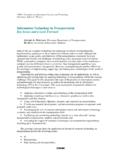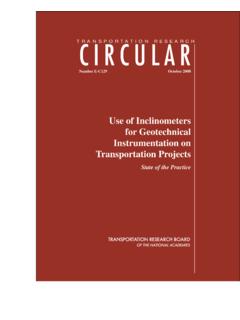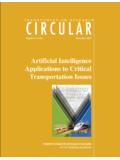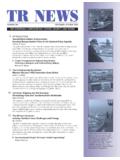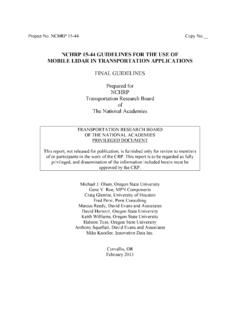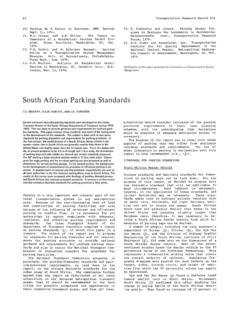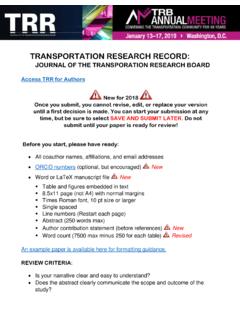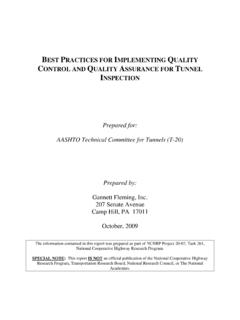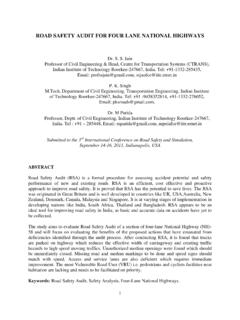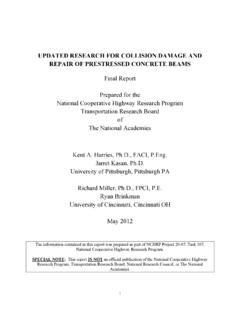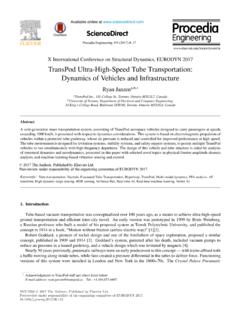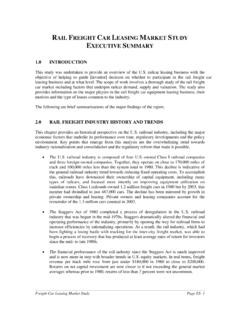Transcription of Nanotechnology in Concrete Materials
1 T R A N S P O R TAT I O N R E S E A R C H. Number E-C170 December 2012. Nanotechnology in Concrete Materials A Synopsis transportation RESEARCH BOARD. 2012 EXECUTIVE COMMITTEE OFFICERS. Chair: Sandra Rosenbloom, Director, Innovation in Infrastructure, The Urban Institute, Washington, Vice Chair: Deborah H. Butler, Executive Vice President, Planning, and CIO, Norfolk Southern Corporation, Norfolk, Virginia Division Chair for NRC Oversight: C. Michael Walton, Ernest H. Cockrell Centennial Chair in Engineering, University of Texas, Austin Executive Director: Robert E. Skinner, Jr., transportation Research Board transportation RESEARCH BOARD. 2012 2013 TECHNICAL ACTIVITIES COUNCIL. Chair: Katherine F. Turnbull, Executive Associate Director, Texas A&M transportation Institute, Texas A&M University System, College Station Technical Activities Director: Mark R. Norman, transportation Research Board Paul Carlson, Research Engineer, Texas A&M transportation Institute, Texas A&M University System, College Station, Operations and Maintenance Group Chair Thomas J.
2 Kazmierowski, Manager, Materials Engineering and Research Office, Ontario Ministry of transportation , Toronto, Canada, Design and Construction Group Chair Ronald R. Knipling, Principal, , Arlington, Virginia, System Users Group Chair Mark S. Kross, Consultant, Jefferson City, Missouri, Planning and Environment Group Chair Peter B. Mandle, Director, LeighFisher, Inc., Burlingame, California, Aviation Group Chair Harold R. (Skip) Paul, Director, Louisiana transportation Research Center, Louisiana Department of transportation and Development, Baton Rouge, State DOT Representative Anthony D. Perl, Professor of Political Science and Urban Studies and Director, Urban Studies Program, Simon Fraser University, Vancouver, British Columbia, Canada, Rail Group Chair Steven Silkunas, Director of Business Development, Southeastern Pennsylvania transportation Authority, Philadelphia, Pennsylvania, Public transportation Group Chair Peter F.
3 Swan, Associate Professor of Logistics and Operations Management, Pennsylvania State, Harrisburg, Middletown, Pennsylvania, Freight Systems Group Chair James S. Thiel, General Counsel, Wisconsin Department of transportation , Legal Resources Group Chair Thomas H. Wakeman, Research Professor, Stevens Institute of Technology, Hoboken, New Jersey, Marine Group Chair Johanna P. Zmud, Director, transportation , Space, and Technology Program, RAND Corporation, Arlington, Virginia, Policy and Organization Group Chair transportation Research Circular E-C170. Nanotechnology in Concrete Materials A Synopsis Prepared by Bjorn Birgisson Anal K. Mukhopadhyay Georgene Geary Mohammad Khan Konstantin Sobolev for the Task Force on Nanotechnology -Based Concrete Materials transportation Research Board transportation Research Board 500 Fifth Street, NW. Washington, transportation RESEARCH CIRCULAR E-C170. ISSN 097-8515. The transportation Research Board is one of six major divisions of the National Research Council, which serves as an independent advisor to the federal government and others on scientific and technical questions of national importance.
4 The National Research Council is jointly administered by the National Academy of Sciences, the National Academy of Engineering, and the Institute of Medicine. The mission of the transportation Research Board is to provide leadership in transportation innovation and progress through research and information exchange, conducted within a setting that is objective, interdisciplinary, and multimodal. The transportation Research Board is distributing this Circular to make the information contained herein available for use by individual practitioners in state and local transportation agencies, researchers in academic institutions, and other members of the transportation research community. The information in this circular was taken directly from the submission of the authors. This document is not a report of the National Research Council or the National Academy of Sciences. Design and Construction Group Thomas J. Kazmierowski, Chair Concrete Materials Section Mohammad S.
5 Khan, Chair Task Force on Nanotechnology -Based Concrete Materials Bjorn Birgisson, Chair Neal S. Berke Steven H. Kosmatka Roger C. Schmitt, Sr. Mark E. Felag Richard A. Livingston Rathinam Panneer Selvam Edward J. Garboczi Anal K. Mukhopadhyay Surendra P. Shah Georgene M. Geary Jan Olek Konstantin Sobolev James D. Grove Claudia P. Ostertag Wynand Jacobus van der Merwe Steyn Wouter Gulden H. Celik Ozyildirim Donald A. Streeter Karin M. E. Habermehl-Cwirzen Laila Raki Thomas J. Van Dam Mohammad Shamim Khan Florence Sanchez Suneel N. Vanikar TRB Staff Frederick D. Hejl, Associate Division Director, Engineer of Materials and Construction Michael DeCarmine, Program Officer Michael Nabinett, Senior Program Assistant transportation Research Board 500 Fifth Street, NW. Washington, Javy Awan, Production Editor; Jennifer Correro, Layout and Proofreading Preface T he mechanical behavior of Concrete Materials depends to a great extent on structural elements and phenomena which are effective on a micro- and nanoscale.
6 The ability to target material modification at the nanostructural level promises to deliver the optimization of material behavior and performance needed to improve significantly the mechanical performance, volume change properties, durability, and sustainability of Concrete . This synopsis is written to assist in the identification of promising new research and innovations in Concrete Materials using Nanotechnology that can result in improved mechanical properties, volume change properties, durability, and sustainability. This publication was developed both for the practitioner who wants a general knowledge of how Nanotechnology can shape and is shaping the future and for the academician who is interested in a compilation of the latest research including detailed references related to Nanotechnology in Concrete . Parts 1, 3, and 4 are on a level that can be comprehended by a reader who has no background in Nanotechnology . Part 1 is a general overview for practitioner and academician alike.
7 Part 3 highlights some of the current implementation case studies, and Part 4 identifies some of the challenges and sets a course for future direction. In Part 2, at the front of each of the main sections is a general description for the practitioner. The body of the section details the state of the art in research and technology in Nanotechnology . This synergy of practical needs and future vision will change the future of Concrete construction in the transportation industry. Bjorn Birgisson Chair, Task Force on Nanotechnology -Based Concrete Materials iii Contents Part 1: Nanotechnology for Concrete : Overview ..1. Part 2: Nanotechnology -Based Research in Concrete to High-Performance Cement and Concrete Materials ..4. Mechanical Formation of Dense Microstructure and More Efficient Cement Hydration ..4. Higher Compressive Strength Higher Tensile Strength, Ductile, and Tougher Improved Aggregate Paste Bond Strength ..9. Improved Concrete Performance Using Nanoporous Thin Film Technology.
8 10. Self-Healing of Microcracks Through Use of Chemistry and Microbes ..10. Nanomaterials for Electrical Conductivity and Stress-Sensing Durability Properties ..11. Reduced Permeability ..11. Improved Shrinkage Sustainable and Safe Concrete Materials and Structures ..12. Sustainable Cements ..12. Degradation of Pollutants and Self-Cleaning Concrete ..13. Concrete with Nonconventional Aggregates ..13. Reactive Powder Concrete for Optimized Design ..14. Multiscale Characterization and Modeling of Concrete ..15. Nanoindentation and Atomic Force Microscopes for Characterization of Concrete ..15. Characterization of the Hydration Process ..17. Nanoscale Model of Portland Cement Concrete ..19. Intelligent Concrete Materials Through Integration of Nanotechnology -Based Sensing Technologies ..20. Self-Sensing and Self-Powered Materials ..20. Nanotechnology -Based Devices ..21. Enhanced Concrete Pavement Design and Construction ..21.
9 Part 3: Implementation Case Photocatalytic Concrete ..22. Nanomodified Concrete for Self-Compacting Concrete and Improved Slipform Paving ..23. Ultra-High-Performance Bridge Elements ..24. Part 4: Future Challenges and Directions ..25. References ..27. v PART 1. Nanotechnology for Concrete Overview N anotechnology is an emerging field of science related to the understanding and control of matter at the nanoscale, , at dimensions between approximately 1 and 100 nm ( ). At the nanoscale, unique phenomena enable novel applications. Nanotechnology encompasses nanoscale science, engineering, and technology that involve imaging, measuring, modeling, and manipulating matter at this length scale. Just how small is nano ? In the serviceability index system of units, the prefix nano . means 1-billionth or 10 9. Therefore 1 nm is 1-billionth of a meter. It's difficult to imagine just how small that is, so here are some examples ( ): A sheet of paper is about 100,000-nm thick.
10 A strand of human DNA is nm in diameter. There are 25,400,000 nm in 1 in. A human hair is approximately 80,000 nm wide. On a comparative scale, if the diameter of a marble was 1 nm, then diameter of the Earth would be about 1 m. Nanoscale particles are not new in either nature or science. Recent developments in visualization and measurement systems for characterizing and testing Materials at the nanoscale have led to an explosion in Nanotechnology -based Materials in areas such as polymers, plastics, electronics, car manufacturing, and medicine. Matter can exhibit unusual physical, chemical, and biological properties at the nanoscale, differing in important ways from the properties of bulk Materials and single atoms or molecules. Some nanostructured Materials are stronger or have different magnetic properties compared to other forms or sizes of the same material . Others are better at conducting heat or electricity. They may become more chemically reactive or reflect light better or change color as their size or structure is altered.
